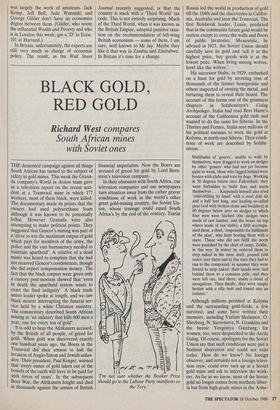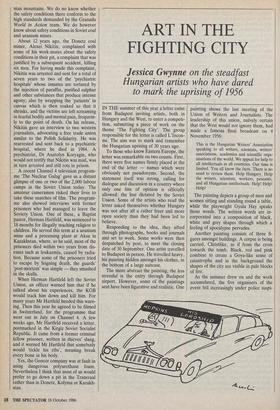BLACK GOLD, RED GOLD
Richard West compares
South African mines with Soviet ones
THE demented campaign against all things South African has turned to the subject of safety in gold mines. This week the Grana- da company's World in Action team gave us a television report on the recent acci- dent at a Transvaal mine in which 177 workers, most of them black, were killed. The documentary made its points that the owners had used polyurethane foam although it was known to be potentially lethal. However Granada were also attempting to make political points. They suggested that Gencor's mining was part of a 'drive to win the maximum output of gold which pays for members of the army, the Police and the vast bureaucracy needed to maintain apartheid'. A relative of a dead miner was heard to complain that she had not received Gencor's condolences, though she did expect compensation money. The fact that the black corpses were given only a cursory post-mortem showed that 'even in death the apartheid system wants to exact the final indignity'. A black trade union leader spoke at length, and we saw black miners interrupting the funeral ser- vice held by a white Christian minister. The commentary described South African mining as 'an industry that kills 600 men a year, one for every ton of gold'.
It is odd to hear the Afrikaners accused, by the British of all people, of greed for gold. When gold was discovered exactly one hundred years ago, the Boers in the Transvaal did their utmost to halt the invasion of Anglo-Saxon and Jewish uitlan- ders. Their president, Paul Kruger, warned that 'every ounce of gold taken out of the bowels of the earth will have to be paid for With rivers of tears'. In the subsequent Boer War, the Afrikaners fought and died in thousands against the armies of British financial imperialsm. Now the Boers are accused of greed for gold by Lord Bern- stein's television company.
In their obsession with South Africa, our television companies and our newspapers turn attention away from the rather graver conditions of work in the world's other great gold-mining country, the Soviet Un- ion, whose tonnage could equal South Africa's by the end of the century. Tsarist 'I'm not sure whether the Booker Prize should go to the Labour Party manifesto or the Tory.' Russia led the world in production of gold till the 1840s and the discoveries in Califor- nia, Australia and later the Transvaal. The first Bolshevik leader, Lenin, predicted that in the communist future gold would be useless except to cover the walls and floors of public lavatories. Meanwhile, he advised in 1921, the Soviet Union should carefully save its gold and 'sell it at the highest price, buy goods with it at the lowest price. When living among wolves, howl like the wolves.'
His successor Stalin, in 1929, embarked on a hunt for gold by arresting tens of thousands of the former bourgeoisie and others suspected of owning the metal, and torturing them to reveal their hoard. The account of this forms one of the grimmest chapters in Solzhenitsyn's Gulag Archipelago. Stalin had read Bret Harte's account of the Californian gold rush and wanted to do the same for Siberia. In the Thirties and Forties, Stalin sent millions of his political enemies to work the gold at Kolyma, in north-east Siberia. Their condi- tions of work are described by Solzhe- nitsyn:
Multitudes of 'goners', unable to walk by themselves, were dragged to work on sledges by other 'goners' who had not yet become quite so weak, those who lagged behind were beaten with clubs and torn by dogs. Working in 50 degrees below zero Fahrenheit, they were forbidden to build fires and warm themselves. . . Karpunich himself also tried 'cold-drilling by hand' with a steel drill six and a half feet long, and hauling so-called peat (soil with broken stone and boulders) at 60 degrees below zero on sledges to which four men were hitched (the sledges were made of raw lumber, and the boxes on top where made of raw slabs); a fifth accompa- nied them, a thief, 'responsible for fulfilment of the plan', who kept beating them with a stave. Those who did not fulfil the norm were punished by the chief of camp, Zeldin, in this way: In winter he ordered them to strip naked in the mine shaft, poured cold water over them and in this state they had to run to the compound; in summer they were forced to strip naked, their hands were tied behind them to a common pole, and they were left out, tied there, under a cloud of mosquitoes. Then finally, they were simply beaten with a rifle butt and tossed into an isolator.'
Although millions perished at Kolyma and the surrounding gold-fields, a few survived, and some have written their memoirs, including Varlana Shalamov, 0. Sliozberg, N. Surovtseva, N. Grankina and the heroic Yevgeniya Ginzburg; for women, too, were despatched to the Arctic Gulag. Of course, apologists for the Soviet Union say that such conditions were just a Stalinist aberration and could not exist today. How do we know? No foreign observer, and certainly not a foreign televi- sion crew, could ever turn up at a Soviet gold mine and ask to interview the work- ers. As far as we know, most of the Soviet gold no longer comes from northern Siber- ia but from high-grade mines in the Arme- nian mountains. We do no know whether the safety conditions there conform to the high standards demanded by the Granada World in Action team. We do however know about safety conditions in Soviet coal and uranium mines.
About 12 years ago, the Donetz coal miner, Alexei Nikitin, complained with some of his work-mates about the safety conditions in their pit, a complaint that was justified by a subsequent accident, killing six men. For having made this complaint, Nikitin was arrested and sent for a total of seven years to two of the 'psychiatric hospitals' whose inmates are tortured by the injection of paraffin, purified sulphur and other substances that produce intense agony; also by wrapping the 'patients' in canvas which is then soaked so that it shrinks, and the victims are left screaming in fearful bodily and mental pain, frequent- ly to the point of death. On his release, Nikitin gave an interview to two western journalists, advocating a free trade union similar to the Polish Solidarity. He was rearrested and sent back to a psychiatric hospital, where he died in 1984. A psychiatrist, Dr Anatolyn Koryagin, who would not testify that Nikitin was mad, was in turn arrested and still rots in prison.
A recent Channel 4 television program- me 'The Nuclear Gulag' gave us a distant glimpse of one or two of the 2,000 labour camps in the Soviet Union today. The amateur cameramen risked their lives to take these snatches of film. The program- me also showed interviews with former prisoners who had managed to leave the Soviety Union. One of these, a Baptist pastor, Herman Hartfeld, was sentenced to 18 months for illegally teaching religion to children. He served this term at a uranium mine and a processing plant at Aksu in Kazakhstan, where, so he said, most of the prisoners died within two years from dis- eases such as leukaemia, caused by radia- tion. Because some of the prisoners tried to escape by feigning death, the guards' 'post-mortem' was simple — they smashed in the skulls.
When Herman Hartfeld left the Soviet, Union, an officer warned him that if he talked about his experiences, the KGB would track him down and kill him. For many years Mr Hartfeld heeded this warn- ing. Then this year he agreed to be filmed in Switzerland, for the programme that went out in July on Channel 4. A few weeks ago, Mr Hartfeld received a letter, postmarked in the Kirgiz Soviet Socialist Republic. It came from a former criminal fellow prisoner, written in thieves' slang, and it warned Mr Hartfeld that somebody would 'tickle his ribs', meaning break every bone in his body.
Yes, the Gencor company was at fault in using dangerous polyurethane foam. Nevertheless I think that most of us would prefer to go down a pit in the Transvaal rather than in Donetz, Kolyma or Kazakh- stan.



















































 Previous page
Previous page